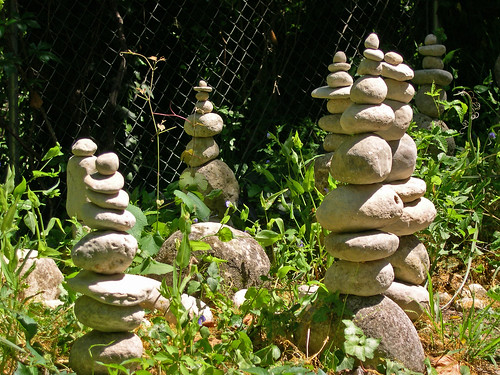I check out garden books from the library every week. It’s rare that I open a book and just know I have to own it. Such was the case with Amy Goldman’s The Heirloom Tomato: From Garden to Table: Recipes, Portraits, and History of the World’s Most Beautiful Fruit. I’ve been browsing it for less than a day and I’ve already ordered it from Amazon.
I wish I had read it a couple of months ago when I was In Search of the Perfect Tomato. At the time I was frustrated by my inability to find concrete information on various tomatoes. After awhile the catalog descriptions become mind-numbing in their sameness. How many ways are there to describe a tomato anyway? Besides catalog descriptions are written to sell a product. I wanted direction and objectivity from the garden blogosphere. Hanna @ This Garden is Illegal writes wonderfully detailed review of her tomato tastings but she is in the minority. My frustration is at an end. Now I have Amy Goldman’s The Heirloom Tomato.
In this book, Ms. Goldman evaluates tomatoes the way a wine reviewer writes about wine. She considers size and weight, shape, color, soluble solids (to get an objective measurement of sweetness), flavor, and texture. In looking at the plants themselves, she describes plant habit, leaf type, yield, and date to maturity. She explains her criteria in more detail before launching into the tomato descriptions.
Before I could settle into the text I was distracted by Victor Schrager’s tomato “portraits”. After feasting with my eyes on his photographs, I could understand why one might not stoop to calling them mere photographs. The Heirloom Tomato has page after glossy page of tomatoes arranged by size, shape, or color on milk glassware in the modern equivalent of a Renaissance still life painting. There are single tomato portraits, too, but I really appreciate contrasting the qualities of the many heirlooms featured. A tomato can be so much more than a smooth, round, red globe.
AJM actually picked this book up at the library, honing in on the final chapter “Recipes”. With our mere seven plants, I doubt that we’ll ever have the excess harvest required to think about eating tomatoes any other way than fresh off the vine. So I skipped back a section to the tomato descriptions. Whenever I read any reviews, (travel, wine, movie, books) I always look at things I’m familiar with first in order to calibrate the reviewer’s tastes and biases against my own.
So it was with great pleasure to turn to the very first tomato description and discover that it is of a cherry tomato I picked last week ‘Black Cherry’. Ms. Goldman approves of my choice: “This tomato tastes like plumstone fruit without the stone.; it bests any bigger black plum or beefsteak.” As if to demonstrate these descriptions are not just catalog marketing, on the same page she says of ‘Yellow Pygmy’, “…looks cute, but no one has ever accused it of being palatable.” That’s what I like! A touch of bitter to temper the sweet.
I have a couple of quibbles about the book design. The tomato descriptions begin with the data for each tomato followed by Ms. Goldman’s more subjective evaluation or some historical tidbits. The data section has headings in small caps but the data itself is in italics…of a very small size. Her description is in a standard font face. Those italics are very difficult to read. In some instances, the italicized part of the tomato entry is more lengthy than Ms. Goldman’s notes on it. All those italics make painful reading–they obscure the fascinating information. One thing I gleaned, though. Heirloom does not seem to be restricted to old varieties, just open-pollinated (that is, not hybrid) varieties.
Two other book design quibbles. In the section table of contents, the most important information is black small caps and italics against a dull green background. And it’s centered-space. This must look nice as design but it is unusable as a table of contents. The main text of the book could use a lot more subheading. Even I, who am very text-oriented, found the unbroken text a bit much. Ms. Goldman’s writing is well-organized into paragraphs and sections, but the book layout doesn’t reinforce this.
I continued reading “The Heirloom Tomato” backwards. In the early chapters Ms. Goldman explains how she grew 1000 tomato plant (two of each variety) for two years in order to write this book. The chapter on how to grow tomatoes, from seed, to seedling, to hardening off, to care and feeding, pruning and picking, and finally gathering seed for next year is a wonderful resource for new and longtime tomato growers alike.
Bottom line: Highly Recommended
This is a book that I not only just bought for myself but that I see myself buying as a gift for others in the years ahead. Now to check out Ms. Goldman’s books on melons and squashes.
An Aside
In the description of ‘Black Cherry’ Ms. Goldman indirectly references a quote thus, “If one of the greatest services a man can render his country is to add a useful plant to its agriculture…” Do you know who said that? I do. But only because I had read it somewhere else just last week. Is this such a common quote in garden writing that it requires no further explanation…that all of you just naturally know the reference? Or would you just assume that it was a phrase of the author?






